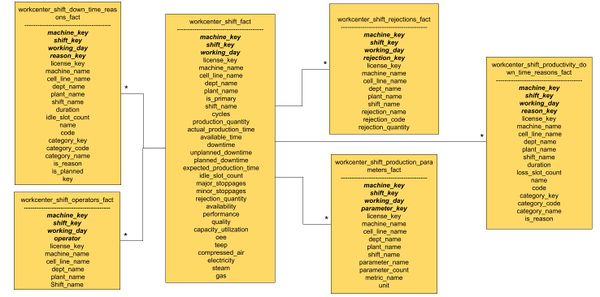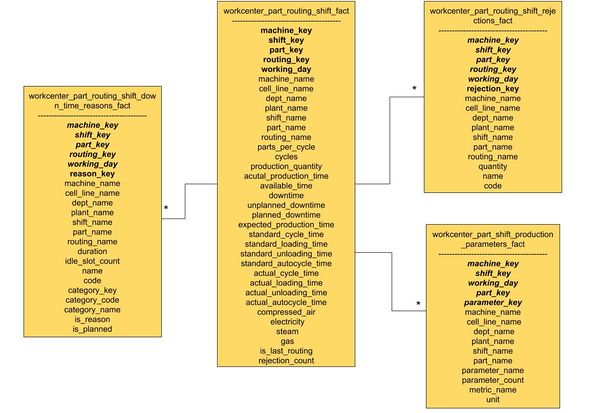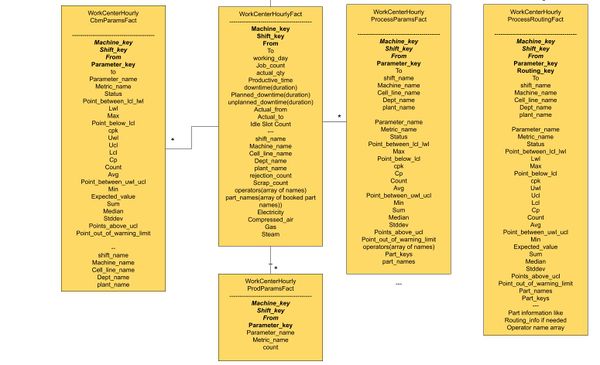Difference between revisions of "Analytics Data Model"
(Tag: Visual edit) |
(Tag: Visual edit) |
||
| Line 53: | Line 53: | ||
'''WorkcenterPartShiftProductionParametersFact:''' | '''WorkcenterPartShiftProductionParametersFact:''' | ||
| + | |||
| + | === '''Hourly Data Model''' === | ||
| + | MInt Part Productivity data, which is data about part level performance. This data is rolled up at the shift level for shift level part productivity analysis. | ||
| + | |||
| + | Here is a diagram that represents the data model. | ||
| + | |||
| + | [[File:MINT Analytics Data Model - WorkcenterHourlyFact.jpg|600x600px]] | ||
| + | |||
| + | The main tables are: | ||
| + | |||
| + | '''WorkcenterHourlyFact:''' Productivity data is centered around a workcenter which is a machine that is performing the task. This table contains the primary hourly level productivity parameters. | ||
| + | |||
| + | '''WorkcenterHourlyCbmParamsFact:''' Condition Based Monitoring (CBM) is the process of monitoring a parameter of condition in a workcenter (vibration, temperature etc.), in order to identify a significant change which is indicative of a developing fault. The table contains information about the CBM parameters, control limits, and details of violations. | ||
| + | |||
| + | '''WorkcenterHourlyProcessParamsFact:''' Process parameters are the parameters dependant on the Part (temperature of Part 1, temperature of Part 2), in order to identify a significant change that is indicative of developing a Quality defect. The table contains information about the Process parameters, control limits, and details of violations. | ||
| + | |||
| + | '''CHECK''' | ||
| + | |||
| + | '''WorkcenterHourlyProcessRoutingFact:''' | ||
| + | |||
| + | '''WorkcenterPartHourlyProdParamsFact:''' | ||
Revision as of 07:42, 22 May 2020
Contents
[hide]Data Model
The Data Model is divided into 3 sections:
- Workcenter Shift Productivity Data Model
- Part Shift Productivity Data Model
- Hourly Data Model
Workcenter Shift Productivity Data Model
MInt Productivity data, which is data about performance. This data is rolled up at the shift level for shift level productivity analysis.
Here is a diagram that represents the data model.
The main tables are:
WorkcenterShiftFact: Productivity data is centered around a workcenter which is a machine that is performing the task. This table contains the primary shift level productivity parameters.
WorkcenterShiftDownTimeReasonsFact: Downtimes represent durations when the machine was non-operational. This table contains information about the downtimes for a workcenter for a shift and the reasons for it.
WorkcenterShiftRejectionsFact: Rejections are quality defects on a workcenter. The table contains information about these quality rejections for a workcenter for a shift and the reasons for it.
WorkcenterShiftOperatorsFact: This table contains information about the operators working on the workcenter for a given shift.
CHECK
*WorkcenterShiftProductivityDownTimeReasonsFact: Captures details of all the downtime incidents occurring on a workcenter when it is running on a given day.
*WorkcenterShiftProductionParametersFact: Captures details of all the production parameters produced on a workcenter when it's running on a given day.
Please refer to the following link for column descriptions.
Examples of using the object model to create dashboards:
- Here is an example of how you can use the data model to analyze average OEE by Workcenters.
ADD VIDEO HERE
Part Shift Productivity Data Model
MInt Part Productivity data, which is data about part level performance. This data is rolled up at the shift level for shift level part productivity analysis.
Here is a diagram that represents the data model.
The main tables are:
WorkcenterPartRoutingShiftFact: The Part Productivity data is centered around a Part that is being produced on the workcenter. This table contains the primary shift level part productivity parameters.
WorkcenterPartRoutingShiftDownTimeReasonsFact: Downtimes represent durations when the machine was non-operational. This table contains information about the downtimes for a Part (when the part was booked) for a shift and the reasons for it.
WorkcenterPartRoutingShiftRejectionsFact: Rejections are quality defects on a workcenter. The table contains information about these quality rejections for a Part for a shift and the reasons for it.
CHECK
WorkcenterPartShiftProductionParametersFact:
Hourly Data Model
MInt Part Productivity data, which is data about part level performance. This data is rolled up at the shift level for shift level part productivity analysis.
Here is a diagram that represents the data model.
The main tables are:
WorkcenterHourlyFact: Productivity data is centered around a workcenter which is a machine that is performing the task. This table contains the primary hourly level productivity parameters.
WorkcenterHourlyCbmParamsFact: Condition Based Monitoring (CBM) is the process of monitoring a parameter of condition in a workcenter (vibration, temperature etc.), in order to identify a significant change which is indicative of a developing fault. The table contains information about the CBM parameters, control limits, and details of violations.
WorkcenterHourlyProcessParamsFact: Process parameters are the parameters dependant on the Part (temperature of Part 1, temperature of Part 2), in order to identify a significant change that is indicative of developing a Quality defect. The table contains information about the Process parameters, control limits, and details of violations.
CHECK
WorkcenterHourlyProcessRoutingFact:
WorkcenterPartHourlyProdParamsFact:


